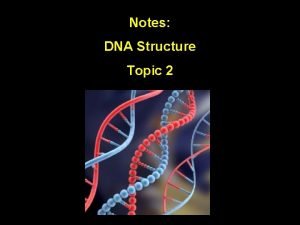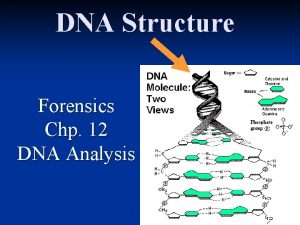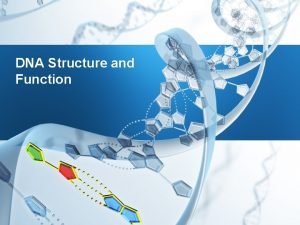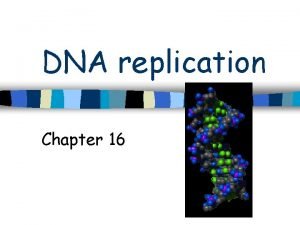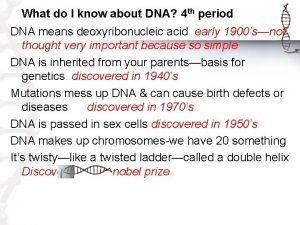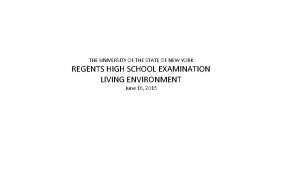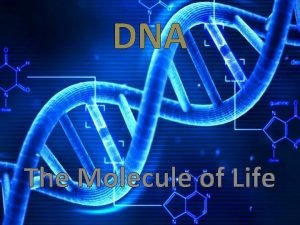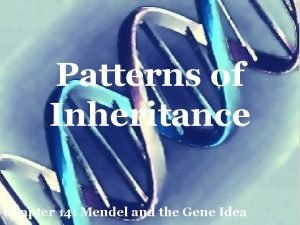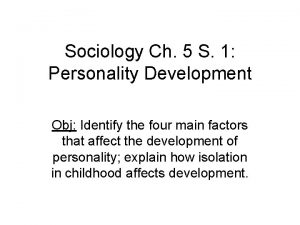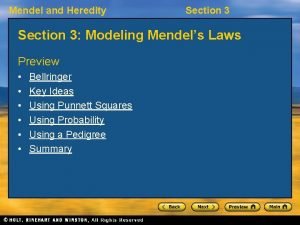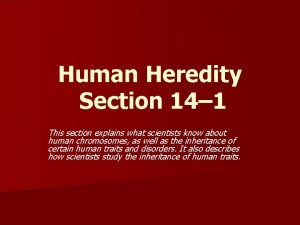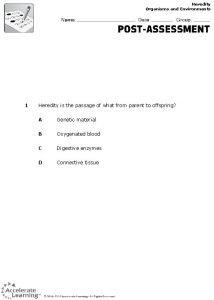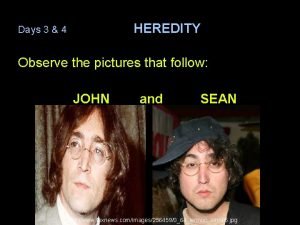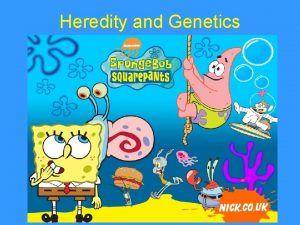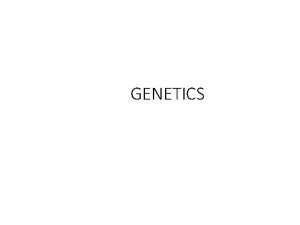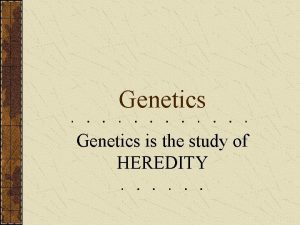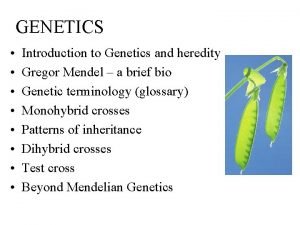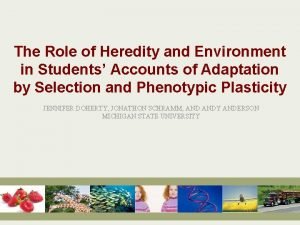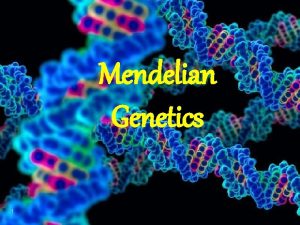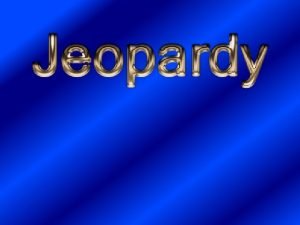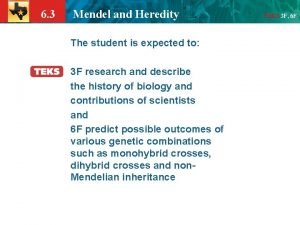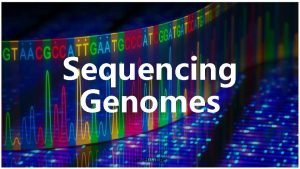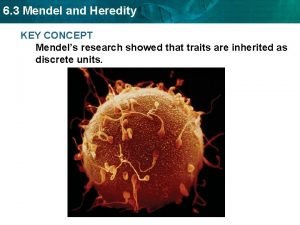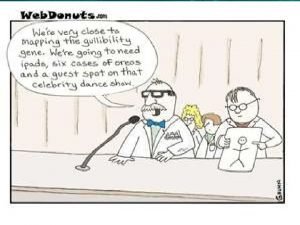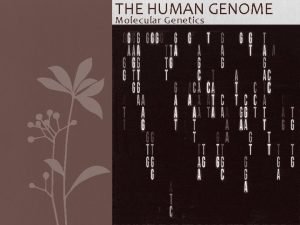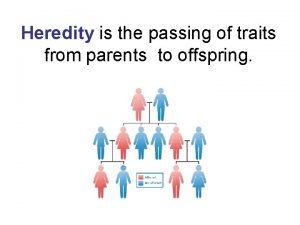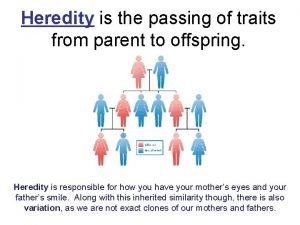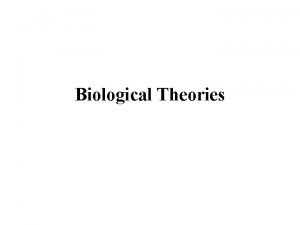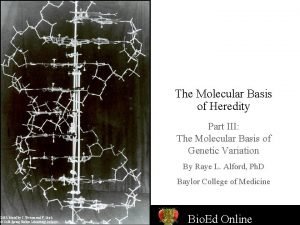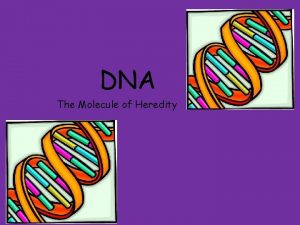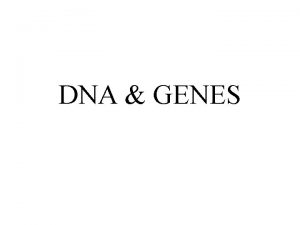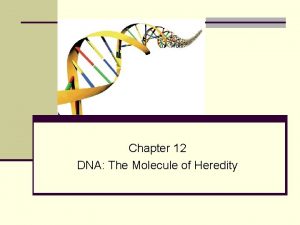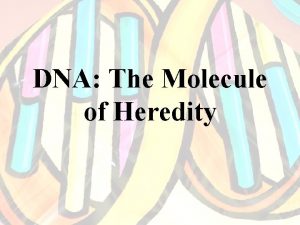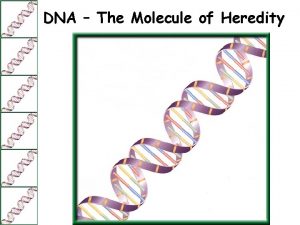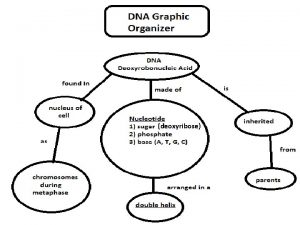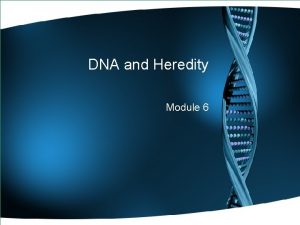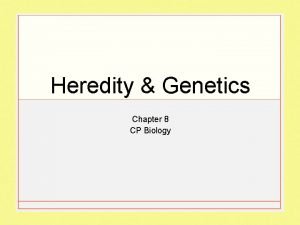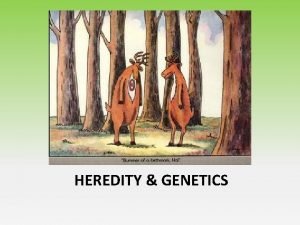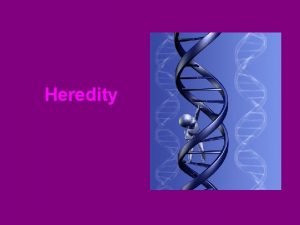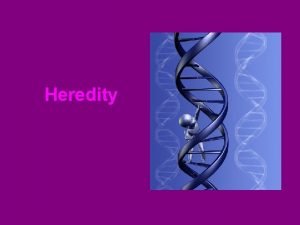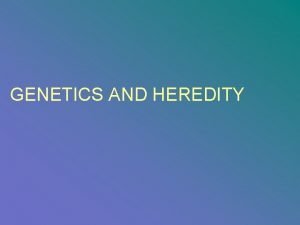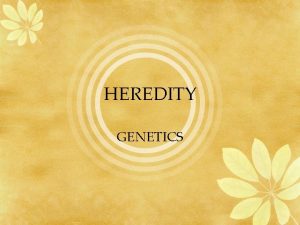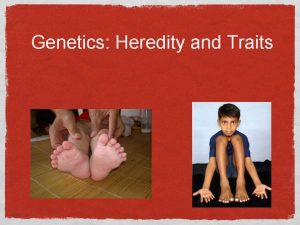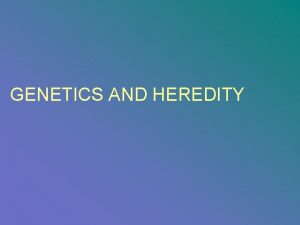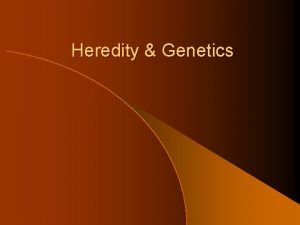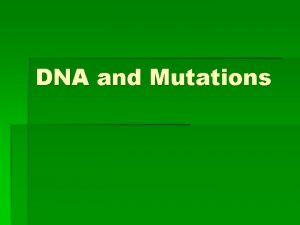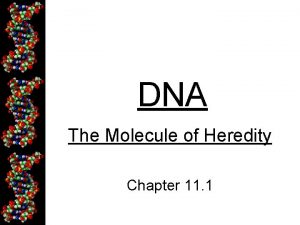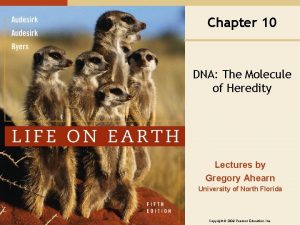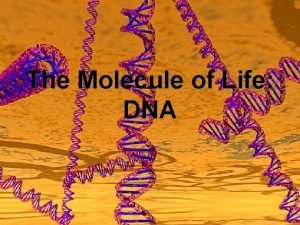Chapter 11 DNA The Molecule of Heredity Do













































- Slides: 45

Chapter 11: DNA- The Molecule of Heredity

Do now : • Living things contain proteins. Your skin, muscles, and bones contain protein. All the actions you perform such as eating, running, and thinking depend on proteins called enzymes. How is this related to DNA?

• DNA determines the structure of proteins – Provide complete instructions for making proteins – Made up repeating units called nucleotides

DNA in Cells • Located in the nucleus of cells as chromosomes • Packed tightly • Consists of more than 30 million base pairs • Complimentary DNA strands – Can use 1 strand to make a copy of the other strand using base pairing

Nucleotides • Make up DNA • 3 parts to a nucleotide: – A simple sugar – A phosphate group – A nitrogen base

Nitrogen Bases • A nitrogenous base is a carbon ring structure that contains one or more atoms of nitrogen • 4 possible nitrogen bases: – Adenine (A) – Guanine (G) – Cytosine (C) – Thymine (T)

Adenine (A) and Guanine (G) • Double-ringed nitrogen bases • Called purines

Thymine (T) and Cytosine (C) • Single-ringed nitrogen bases • Called pyrimidines


Structure of DNA • long zipper that is twisted into a coil like a spring. Something twisted into a coil is called a helix. • DNA is made of two strands that are twisted into a coil, so it is called a double helix.

How can DNA do so much with so little? • The key to variety in organisms is the sequence, or order, of the four nucleotides. • Ex: A-T-T-G-A-C carries different information than the sequence T-C-C-A-A-A. EAT ATE TEA

DNA Replication • Making a copy of DNA • DNA is copied before cell division – During the S phase of interphase • DNA will separate into 2 strands • Unzips DNA by breaking hydrogen bonds to unwind the double helix • Makes new complimentary strands through base-pairing

• After DNA is replicated, DNA will have 1 old strand 1 new strand


What is the role of RNA in a cell? Think of a car factory and an assembly line. A car is a complicated piece of machinery. But cars are built by following simple steps. Engineers tell workers how to make the cars, and workers follow the directions to build the cars on the assembly line. Suppliers bring parts to the assembly line so they can be used to build the cars. This is similar to the role of DNA and RNA in a cell. DNA gives the instructions to make proteins. Workers build proteins. Other workers bring the parts, in this case, amino acids, to the assembly line. In our example the workers are the RNA. Just as in a typical factory, workers have specific tasks. So does RNA

What does RNA look like? • nucleic acid. • RNA is a single strand. • instead of thymine, RNA has uracil. • In RNA uracil (U) binds with adenine.

Example: DNA A G C T G A C T G m. RNA

Example: DNA m. RNA A U G C C G T A G C A U C G T A G C

Transcription • First, a portion of the DNA molecule unzips. • Free RNA nucleotides pair with the nucleotides on the DNA strand. • The m. RNA strand is complete when the RNA nucleotides form a strand by bonding together. • The m. RNA strand breaks away and the DNA strands rejoin. • The m. RNA strand leaves the nucleus and enters the cytoplasm.

Messenger RNA (m. RNA) • Brings instructions from DNA out of the nucleus and into the cytoplasm

Ribosomal RNA (r. RNA) • Binds to messenger RNA • Uses the instructions from DNA to put amino acids in the correct order

Transfer RNA (t. RNA) • Delivers the amino acids to the ribosomes to be made into a protein


• The Genetic Code • nucleotide sequence transcribed from DNA to a strand of m. RNA is a genetic message that has all the information needed to build a protein. • The message is in a special language that uses nitrogenous bases as the alphabet.

• proteins are made up of amino acid chains. • There are 20 different amino acids. • These amino acids are made from only four nitrogenous bases.


• Each group of three nitrogenous bases is known as a codon. • Ex: The codon for the amino acid alanine is G-C-U. The codon for lysine is A-A-A. • Every amino acid has a three-letter codon • In amino acid chain there is codons that tell m. RNA when to start and when to stop.

Do Now: What is the differences between DNA and RNA?

DNA RNA (3 types) Sugar Deoxyribose Ribose Bases G, C, A, T G, C, A, U (uracil) Structure Doublestranded Single-stranded Location in a Cell Base Pairing Only in the nucleus C-G and A-T In nucleus and cytoplasm C-G and A-U

What is ……? Replication Transcription Translation protein formation CENTRAL DOGMA

Translation • The process of changing the information in m. RNA into an amino acid chain in protein is called translation.

• 1. The m. RNA moves to the cytoplasm. • 2. A ribosome (r. RNA) attaches itself to the start codon, A-U-G, on the m. RNA. • 3. Transfer RNA (t. RNA) molecules, carrying amino acids, approach the ribosome. The nitrogenous base sequence that is the complement to the m. RNA sequence is the anticodon. If the m. RNA codon is G-C-C, the t. RNA anticodon is C-G-G. For every codon on m. RNA there is an anticodon on t. RNA. • 4. The ribosome attaches the anticodon to the codon and the amino acids bond. The ribosome then slides to the next codon. • 5. Again the ribosome attaches the anticodon to the codon, amino acids bond, and the ribosome slides over. • 6. This translation process continues until the stop codon is reached. At this point the amino acids have formed a chain and when the stop codon is reached, the chain is released.


1. The 3 main types of RNA are ___, & ___. 2. Copying part of a nucleotide sequence of DNA into a complementary sequence in RNA is called ____. 3. During the process of _____, the information carried by m. RNA is used to produce proteins. 4. Each t. RNA molecule contains 3 unpaired bases, called the _____, which ensure that amino acids are added in the correct sequence.

Do Now: What is mutation?

Mutations • Any change in the sequence of DNA • Can be caused by errors in: –DNA replication –Transcription –Cell division –External agents

Mutations in Reproductive Cells: Birth Defects • Within the egg or sperm cells • Can produce new traits • Can result in proteins that do not work (can kill organism) • Could have positive effects – Faster – Stronger – Important in the evolution of a species

Mutations in Body Cells • Not passed on to offspring • May impair cell function • Can affect genes that control cell division (cancer)

• Radiation from the sun, X rays, or radioactive materials can change the DNA of skin, muscle, or bone cells. • Since these cells are not sex cells, the changes in the DNA are not passed on to offspring. • However, the organism may be harmed by the mutation. When mutated cells divide they pass on the mutation.

• THE DOG BIT THE CAT • THE DOG BIT THE CAR

Point Mutation • Change in 1 N-base in DNA • CGATTACGC (normal DNA) CGATTTCGC (mutated DNA)

• THE DOG BIT THE CAT (correct) • THE DOB ITT HEC AT (deleted base (G)) • THE DOC GBI TTH ECA T (added base (C))

Frameshift Mutation • 1 N-base is added or deleted • Changes all codons from that point on • May cause no problems or can be severe • More dangerous than point mutations

Chromosomal Mutations • Involve many genes • Usually very bad

Homework : • What are the Causes of Mutations? • Can DNA be repaired?
 Is dna a nucleic acid
Is dna a nucleic acid Dna molecule two views
Dna molecule two views Dna function
Dna function Phosphodiester bond
Phosphodiester bond Molecule dna
Molecule dna Describe structure of dna
Describe structure of dna Griffith’s transformation experiments
Griffith’s transformation experiments Which process produces only identical offspring
Which process produces only identical offspring Dna the molecule of life
Dna the molecule of life Chapter 11 human heredity section 11-3
Chapter 11 human heredity section 11-3 Chapter 11 complex inheritance and human heredity test
Chapter 11 complex inheritance and human heredity test Extra x
Extra x Dice and coin
Dice and coin Chapter 17 the beginning of the life cycle
Chapter 17 the beginning of the life cycle Replication fork
Replication fork Bioflix activity dna replication dna replication diagram
Bioflix activity dna replication dna replication diagram Coding dna and non coding dna
Coding dna and non coding dna Enzyme involved in dna replication
Enzyme involved in dna replication Chapter 11 dna and genes
Chapter 11 dna and genes Brainpop heredity worksheet answer key
Brainpop heredity worksheet answer key Heredity characteristics include body build
Heredity characteristics include body build Mendelian genetics concept map
Mendelian genetics concept map Section 3 mendel and heredity
Section 3 mendel and heredity Section 14-1 human heredity
Section 14-1 human heredity Heredity is best described as the -
Heredity is best described as the - Pictures of heredity
Pictures of heredity Heredity examples
Heredity examples Genetics
Genetics ____________ is the study of heredity.
____________ is the study of heredity. Inheritance vs heredity
Inheritance vs heredity Intermediate inheritance
Intermediate inheritance Chromosome structure
Chromosome structure Importance of heredity and environment in education
Importance of heredity and environment in education Section 3 mendel and heredity
Section 3 mendel and heredity Heredity terminology
Heredity terminology What are the basic units of heredity
What are the basic units of heredity Mendel 9 3 3 1
Mendel 9 3 3 1 Sanger sequencing
Sanger sequencing Section 3 mendel and heredity
Section 3 mendel and heredity Section 3 mendel and heredity
Section 3 mendel and heredity Heredity
Heredity Heredity
Heredity Organisms that reproduce asexually
Organisms that reproduce asexually Heredity and crime
Heredity and crime 45 chromosomes
45 chromosomes Molecular basis of heredity
Molecular basis of heredity
